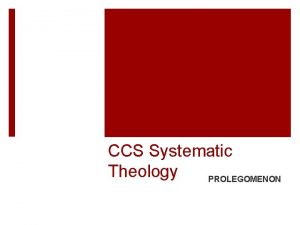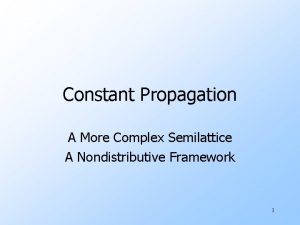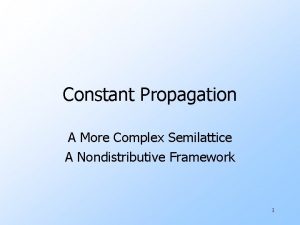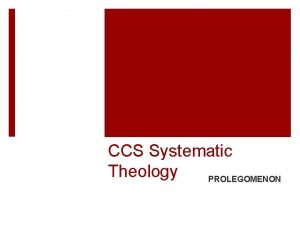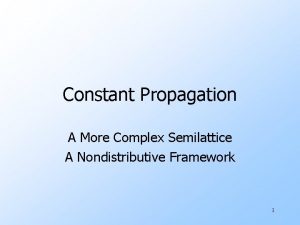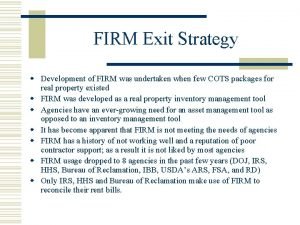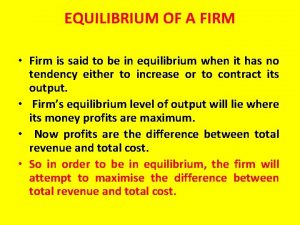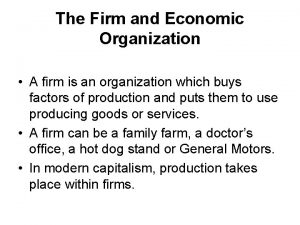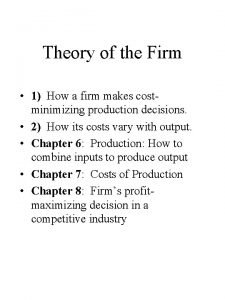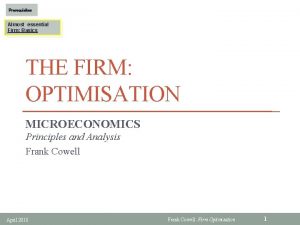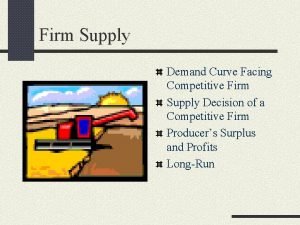The firm as a semilattice of activity prolegomenon






























- Slides: 30

The firm as a semilattice of activity: prolegomenon to a theory of the firm Keiran Sharpe UNSW, Canberra

Introduction • Presents a new theory of agency – ‘narrative theory’ – which draws on Philosophy and Sociology • Narrative theory is a theory of planning rather than of decision making • Narrative theory is used to propose a new theory of the firm which can be used to unify various models used in Management theory • Very preliminary stage of development

What is a narrative? • A narrative is a partial order of activity that is undertaken for some purpose • Each narrative has a beginning and an end – i. e. the partial order of actions has a top (� ) and bottom (� )

A simple narrative of activity d c f e a b figure 1

Events and Episodes • It’s natural in narrative theory to ask how we might concatenate collections of events – which can be thought of as individual ‘pages’ in the narrative – to form episodes – which may be thought of as ‘chapters’ • The reason we’re interested in doing this is that we think that agents plan by intending to implement chapters – or coarse plans of action – first, which they then refine later into individual pages – or actions

Episodes as partition blocks • Formally, this becomes a query about what conditions must be imposed on blocks and relations between blocks of partitions of the poset. • The conditions imposed should preserve the order and succession relations

Conditions for coarsening a poset • Convexity of blocks • e-Connectedness • e-Closure

Convexity • A set is convex if, whenever we have: b, d B, c A and b �c �d, we have c B. where B is a block of a partition of the poset, A.

e-Connectedness • A set is an upper core of a convex set B (A), and is denoted U(B), when it satisfies: • U(B) b �for all b B • U(B) B = � • B is connected on B U(B), and • U(B) C (A). • Similarly for lower core • e-Connectedness holds if B is connected on the union of B and its upper core and on the union of B and its lower core

e-Closure • a partition, π, is said to be upper e-Closed if each up-path of each element, b, of each set, B, intersects one and only one set, C, containing an upper core, U(B), of that set; i. e. , • for all b B , each up-path of b intersects just one set, C , where U(B) C.

Coarser and finer descriptions • It can then be shown that, if the above three conditions are imposed, then the partition of a partially ordered set is monotonic (orderpreserving) and, in fact, also preserves the succession relation • The following diagrams give examples of various partitions that satisfy the above conditions

A partition of a simple narrative d c f e a b figure 2

Another partition of that narrative d c f e a b figure 3

… and another one d c f e a b figure 4

The set of coarsened partitions • The set of coarsened partitions also has a structure • The set of partitions is a poset • The set of partitions is a join semilattice • The following diagram gives the semilattice for the set of partitions of the narrative given in the first diagram

A semilattice of narratives (a&b&c&d&e&f) (a&b)(c&d&e) (a&b)(d&e) (a&b) (c&d&e) (d&e) figure 5 (a&b)(c&d&e&f) (a&b)(d&e&f) (c&e)(d&f) (c&d)(e&f)

Choices between narratives • Our interest in narratives derives from the fact that we think that agents choose between alternative narratives when planning what to do • Two plans are said to be alternative ways of implementing a given, coarser plan, if they both refine the coarser plan but have no common refinement

The structure of choices • The set of alternative partitions of different narratives that implement a single, ultimately coarse – or abstract – plan forms a join semilattice • An example of a semilattice of plans related to the narrative given in figure 1 is given in the following diagram

A simple example • In this example, we suppose that the are two possible ways of jointly implementing activities d & e, and two possible way of implementing activities c & f • Hence, there are four possible narratives: {(c. I, f. I), (d. I, e. I)} {(c. I, f. I), (d. II, e. II)} {(c. II, f. II), (d. I, e. I)} {(c. II, f. II), (d. II, e. II)}

A semilattice of alternatives {c. I, d. I, e. I, f. I} v 1 {c. I, d. II, e. II, f. I} v 2 {c. II, d. I, e. I, f. II} figure 3 v 3 {c. II, d. II, e. II, f. II} v 4

Implementing plans • The decision to proceed with one narrative over another can also be understood as the decision to refine plans in such a way as to arrive at the chosen narrative • In the case of certainty, the desired narrative can be reached through the semilattice of plans with probability 1

Planning under uncertainty • In general, planners and decision makers make mistakes or ‘trembles’ when determining what to do – especially in organisations • The problem then becomes one of how best to allocate decision making resources throughout the organisation to maximise the expected value of narratives

The planner’s problem

Why firms exist • Firms exist when the expected rate of return to organising or coordinating the selection of narratives is greater than the cost of capital • If we let V(z) = the maximum value function for the above problem, and r is the cost of capital, then a firm exists if d. V(z)/dz > r. • This is a ‘Williamsonian’ explanation of the existence of firms – hierarchy outperforms the market

Incremental versus radical change • The application of Kuhn-Tucker to the problem of hierarchical organisation naturally presupposes the usual convexity conditions • If these are not satisfied – so that there are, say, increasing returns to investments of z in parts of the semilattice – then it may pay to forgo incremental improvements in organisational behaviour to secure discontinuous or discrete improvements (Hammer & Champy)

Volatility and planning • increases in the volatility of the operating environment of firms mean that top-down, high-level strategic planning is made otiose, and that strategic resources ought to be allocated closer to the coal face (Mintzberg). • This is demonstrated by way of a rather contrived construct

Mean preserving semilattices • A semilattice is said to be mean preserving if for any two distinct terminal nodes, j′ and j″: • and is mean dispersing otherwise.

Examples of semilattice types An example of a mean preserving semilattice is the following: An example of a mean dispersing semilattice is the following:

Investing in decision making • It can then be shown that, in mean preserving semilattices, it certainly pays to allocate management resource to the lowest decision nodes, whilst this is not true for mean dispersing semilattice • This is suggestive of the intuitive conclusion that the more entropic the environment the greater should be the local allocation of recourses

Conclusions • We have put forward a new model of agency • This is a model of hierarchical planning • This model has a natural application to organisations and firms • The model allows us to unify various propositions from theory of the firm into a single analytical framework • The model is immature • There is plenty of potential for further work
 Dynamic strategic activity systems help a firm to maintain
Dynamic strategic activity systems help a firm to maintain Sơ đồ cơ thể người
Sơ đồ cơ thể người Công thức tiính động năng
Công thức tiính động năng Các số nguyên tố là gì
Các số nguyên tố là gì đặc điểm cơ thể của người tối cổ
đặc điểm cơ thể của người tối cổ Tỉ lệ cơ thể trẻ em
Tỉ lệ cơ thể trẻ em Các châu lục và đại dương trên thế giới
Các châu lục và đại dương trên thế giới ưu thế lai là gì
ưu thế lai là gì Các môn thể thao bắt đầu bằng tiếng nhảy
Các môn thể thao bắt đầu bằng tiếng nhảy Tư thế ngồi viết
Tư thế ngồi viết Thẻ vin
Thẻ vin Hình ảnh bộ gõ cơ thể búng tay
Hình ảnh bộ gõ cơ thể búng tay Cái miệng bé xinh thế chỉ nói điều hay thôi
Cái miệng bé xinh thế chỉ nói điều hay thôi Từ ngữ thể hiện lòng nhân hậu
Từ ngữ thể hiện lòng nhân hậu Trời xanh đây là của chúng ta thể thơ
Trời xanh đây là của chúng ta thể thơ Tư thế ngồi viết
Tư thế ngồi viết Ví dụ giọng cùng tên
Ví dụ giọng cùng tên Gấu đi như thế nào
Gấu đi như thế nào Thơ thất ngôn tứ tuyệt đường luật
Thơ thất ngôn tứ tuyệt đường luật Hổ đẻ mỗi lứa mấy con
Hổ đẻ mỗi lứa mấy con đại từ thay thế
đại từ thay thế Thế nào là hệ số cao nhất
Thế nào là hệ số cao nhất Diễn thế sinh thái là
Diễn thế sinh thái là Vẽ hình chiếu vuông góc của vật thể sau
Vẽ hình chiếu vuông góc của vật thể sau Lp html
Lp html Thế nào là mạng điện lắp đặt kiểu nổi
Thế nào là mạng điện lắp đặt kiểu nổi Cách giải mật thư tọa độ
Cách giải mật thư tọa độ Lời thề hippocrates
Lời thề hippocrates Vẽ hình chiếu đứng bằng cạnh của vật thể
Vẽ hình chiếu đứng bằng cạnh của vật thể Tư thế worms-breton
Tư thế worms-breton Quá trình desamine hóa có thể tạo ra
Quá trình desamine hóa có thể tạo ra

































